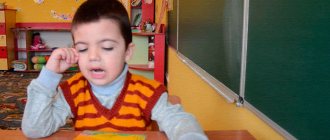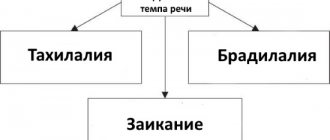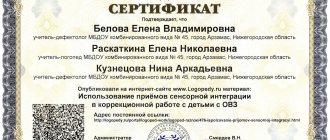Introduction
Relevance of the topic Children with speech impairments are children who have deviations in speech development with normal hearing and intact intelligence. Speech disorders are diverse; they can manifest themselves in impaired pronunciation, grammatical structure of speech, poor vocabulary, as well as impaired tempo and fluency of speech.
According to the severity, speech disorders can be divided into those that are not an obstacle to learning in a public school, and severe disorders that require special training.
However, in mass children's institutions, children with speech disorders also need special help. Many kindergartens have speech therapy groups, where children are assisted by a speech therapist and teachers with special education. In addition to speech correction, children are involved in the development of memory, attention, thinking, gross and fine motor skills, and are taught literacy and mathematics.
School-age children receive assistance at speech therapy centers at secondary schools. Children with pronunciation deficiencies, writing impairments caused by speech underdevelopment, and children who stutter are sent to speech centers. Correctional work is carried out in parallel with school classes and greatly contributes to overcoming school failure. The success of speech therapy classes at school largely depends on how much the family helps to consolidate the acquired skills of correct speech.
With severe speech impairments, it is impossible to educate children in mass children's institutions, so there are special kindergartens and schools for children with severe speech impairments.
The main sign of severe speech impairment is a pronounced limitation of the means of verbal communication with normal hearing and intact intelligence. Children suffering from such disorders have a poor speech reserve, some do not speak at all. Communication with others in this case is very limited. Despite the fact that most of these children are able to understand speech addressed to them, they themselves are deprived of the opportunity to verbally communicate with others. This leads to a difficult situation for children in the group: they are completely or partially deprived of the opportunity to participate in games with peers and in social activities. The developmental influence of communication is minimal in such conditions. Therefore, despite sufficient opportunities for mental development; In such children, secondary mental retardation occurs, which sometimes gives rise to the misconception that they are intellectually inferior. This impression is aggravated by the lag in mastering literacy and understanding arithmetic problems.
So, speech disorders lead to numerous problems for the child in the personal sphere, forming complexes in him, deforming his personality. That is why it is important to promptly identify and eliminate existing speech defects and disorders as much as possible for each individual situation. And here, special attention should be paid to the psychological background of the child’s existence, for which it is important to get a clear idea of the psychological and pedagogical characteristics of children with speech disorders. This is important for the child, the success of his personal development, studies, and socio-psychological comfort. But the question of the psychological and pedagogical characteristics of children with speech disorders in the specialized literature is considered extremely poorly and often in relation to a specific speech pathology, without emphasizing the general problems. Thus, the relevance of this research topic arises from the contradiction between the insufficient information coverage of the problem and its high practical significance in the work of speech therapists, preschool teachers, school psychologists, teachers, and all those who work with children who have one form or another of speech disorders.
The object of the study is children with speech disorders.
The subject of the study is the psychological and pedagogical characteristics of children with speech disorders.
Hypothesis: speech disorders determine the characterological and behavioral specificity of the child’s personality.
The purpose of the work is to analyze the vision of the problem of development of children with speech disorders in modern psychological and pedagogical literature.
Job objectives:
- reveal an understanding of speech, its role, meaning and functions in scientific literature,
- define speech disorders,
- consider the issue of classification of speech disorders
- give psychological and pedagogical characteristics of children with speech disorders.
Research methods. In accordance with the logic of the study, to solve the problems, a theoretical and methodological analysis of psychological, pedagogical, philosophical, economic, sociological and special literature on the problem under study was used, as well as the study of mass and innovative pedagogical activities.
Another common type of speech disorder is dysarthria.
Dysarthria is an altered pronunciation that occurs as a result of organic damage to the brain or peripheral nervous system. The main distinguishing feature of dysarthria is that with this disorder, the reproduction of not some individual sounds, but all pronunciation functions, suffers.
Such children have limited mobility of facial muscles. During speech and facial expressions, the child’s face remains frozen, emotions and experiences are weakly reflected on it, or not reflected at all. The speech of children with this disorder is unclear, blurred, sound pronunciation is weak and quiet. With dysarthria, the respiratory rhythm is disrupted. Speech loses fluency - sometimes speeding up, sometimes slowing down.
A characteristic feature of this deviation is a defect in sound pronunciation and voice, which is combined with disruptions in motor skills and speech breathing. In comparison with dyslalia, dysarthria is characterized by a violation of the pronunciation of not only consonants, but also vowels. Moreover, the vowels seem to be specially lengthened by the child in such a way that in the end they are all close in sound to the neutral sounds “a” or “o”. With dysarthria, consonant sounds at the beginning or end of a word are pronounced with some tension, sometimes they are heard with overtones. Children also exhibit melodic-intonation inconsistencies and violations of grammatical structure.
1.1. Understanding speech, its meaning and functions in scientific literature
Speech is the highest mental function, which is the main means of expressing thoughts. Within the framework of the created A.R. Luria neuropsychology considers speech function both from the point of view of its psychological characteristics and brain organization. The complexity of the structure of speech is emphasized, in which two main levels are distinguished: 1) gnostic and praxic; 2) semantic [25, p. 79].
Gnostic and praxic functions in the structure of the speech function of A.R. Luria regarded them as basic, over which the semantic level of speech activity is systematically built up throughout life, associated with the use of language means - words, phrases constructed according to the rules of grammar.
The important role of A.R. Luria gave an indirect character to the speech function. He pointed out that speech activity requires various non-verbal supports, such as optical images and symbols of objects, ideas about quantity, time, space, etc., and at the same time it itself serves as an intermediary. Without speech it is impossible to master any field of knowledge, even mathematics, physics, chemistry, etc. This means that:
1) the acquisition of speech requires enormous and at the same time multimodal brain costs: it cannot be mastered without the formation of multiple associative connections between the most different areas of the brain;
2) mastery of any higher mental activity is impossible without activation of the pathways leading to the speech zones of the brain, and if possible, then in a significantly limited volume or in a roundabout way, such as in case of deafness, often referred to in everyday life as deaf-mutes [25, p. . 94-96].
Speech is a form of human communication through language. Speech includes the processes of generating and perceiving messages for the purposes of communication or for the purposes of regulation and control of one’s own activities. The structure of speech activity includes the phases of orientation, planning (in the form of “internal programming”), implementation and control. Depending on the type of speech activity, speech is distinguished into internal and external (oral and written) [26, p. 99].
Inner speech is various types of use of linguistic meanings outside the process of real communication. N.I. Zhinkin and A.N. Sokolov distinguishes three main types of inner speech:
1) internal pronunciation - “speech to oneself”, preserving the structure of external speech, but devoid of phonation, i.e., pronouncing sounds, and is typical for solving mental problems in difficult conditions;
2) internal speech itself, when it acts as a means of thinking, uses specific units (code of images and schemes, subject code, subject meaning) and has a specific structure, different from the structure of external speech;
3) internal programming, i.e. the formation and consolidation in specific units of the idea (type, program) of a speech utterance, the whole text and its content parts (etc.) [13, p. 106].
In ontogenesis, internal speech is formed in the process of internalization of external speech [31, p. 73]. L.S. Vygotsky considered inner speech as a compressed program of a coherent utterance [7, p. 213-217]. The expansion of the internal semantic scheme into an external statement is ensured by predicativity, which is expressed in words denoting actions, the rhythmic-intonation structure of speech and other non-formalizable components of verbal behavior. The mechanism for generating a statement, according to L.S. Tsvetkova, consists of four links: the first link begins with the formation of a motive, which in the second link is objectified in the design; in the third link, the plan is realized at the level of internal speech in the form of an internal psychological program of utterance, for which the main thing is semantics and predicativity; in the fourth link, this program is implemented in external speech on the basis of the laws of grammar and syntax of a given language [40, p. 88].
I.N. Gorelov [11] distinguishes the following stages in the process of generating a statement:
1. Motive (setting for communication).
2. Stage of communicative intention.
3. The moment of formation of the semantic content of the future utterance in the Code of Criminal Procedure (according to Zhinkin), i.e., the stage of the general plan in which a holistic semantic “picture” of the future utterance is formed: in the presence of meaning and semantics, there are no specific words and syntactic structures [14, p. 21].
4. Code.
5. Expanding the nuclear meaning (theme).
6. Syntactic scheme.
7. Grammatical structuring and morphemic selection of specific vocabulary.
After seven stages of speech production, the nasyllabic motor program of external speech is implemented. All stages of speech production are implemented quickly, in addition, the stage of speech production control is carried out in parallel. In addition to external and internal, there are impressive (perception and understanding) and expressive (reproduction) speech. The speech function occupies a key position in the development of the psyche. It is the main way of communication between people and the main tool for understanding the world. Speech activity would be impossible without mastery of the means of language, which are organized into special systems (codes). Each speaker can draw from these systems the words and rules he needs to construct an utterance.
The phonemic system of a language (phonemic code) is a set of basic means of conveying thoughts in words. The central unit of this code is the phoneme.
Communicative speech is divided into dialogical (situational and non-situational) and monological. Dialogue speech, especially situational speech, is assessed as simpler, since paralinguistic means of expressing thoughts (gestures, facial expressions, intonation) occupy a much greater place in it than in monologue. Typically, speech automatisms include ordinal and affectively colored speech (exclams, swearing, etc.) [26, p. 101-102].
Currently, thanks to the successes of neuropsychology, it has been established that speech has a dynamic cerebral organization, and specific zones that carry out its different aspects have been identified. Only the totality of all speech zones ensures the implementation of the speech function as a whole, however, in ensuring its individual types, different parts of the brain have priority.
How to work with preschool children
Children under seven years old are especially interested in topics related to animals and natural phenomena. Kids learn to identify details characteristic of a particular time of year. That is why, in order to develop their speech skills, practical interaction with objects, taking part in various activities, and observing natural phenomena are mandatory.
Exercises to develop logic and memory should be present as training elements in the methodological block for each new topic. For preschoolers, exercises that help teach children to correctly compare objects and identify their common features, group by specific features or purpose are considered effective. Moreover, it is important that in the process the child learns to give accurate answers to the questions posed.
Classes with preschoolers are based on children's knowledge of the environment. Among the topics in which educational didactic games are conducted, it is worth noting:
- clothing items;
- names of professions;
- dishes and kitchen utensils;
- vegetables and fruits;
- toys;
- Seasons.
1.2. Speech disorders and their causes
Speech disorders, according to the opinion of S.L. Volkova and R.I. Lalaeva, mean disorders, speech pathology, deviations from the speech norm accepted in a given language environment in the process of functioning of the mechanisms of all types and components of internal and external speech: oral (phonetic, lexical-grammatical, tempo-rhythmic, melodic-intonation components) and written, completely or partially preventing verbal communication, limiting the possibilities of human social adaptation. Violations, as a rule, are caused by deviations in the psychophysiological mechanism of speech, do not correspond to age, cannot be overcome independently and can have an impact on a person’s mental development. The specificity of speech disorders depends on the time of their manifestation (during the process of speech development or after its completion), on the level of mental and intellectual development, on the influence of surrounding and other factors [23, p. 41-42].
Among the factors contributing to the occurrence of speech disorders in children, a distinction is made between unfavorable external (exogenous) and internal (endogenous) factors, as well as environmental conditions.
The main causes of pathology in children’s speech, according to O.V. Pravdina, are:
1) various intrauterine pathologies that lead to impaired fetal development (the most severe speech defects occur when fetal development is disrupted in the period from 4 weeks to 4 months; the occurrence of speech pathologies is facilitated by toxicosis during pregnancy, viral and endocrine diseases, injuries, Rh incompatibility -factor, etc.);
What is dyslalia?
Speaking briefly about the psychological characteristics of children with speech disorders of various types, it is difficult to characterize each type of speech defect. Let's pay attention to the most common deviations.
For example, dyslalia is more common than other types of speech disorders. The essence of this disorder lies in the incorrect pronunciation of sounds, which is expressed in their replacement and distortion. In the presence of such a defect, the child is not able to recognize sounds, which leads to incorrect perception of syllables. Thus, dyslalia prevents the correct perception of words both by the speaker himself and the person who listens to him.
It is very common to erroneously reproduce voiced and noisy sounds as paired deaf ones. For example, “zh” is heard as “sh”, “d” - as “t”, “z” - as “s”, etc. Many children do not distinguish between whistling and hissing sounds, front-lingual and posterior-lingual, lingual hard and soft.








